
The British Empire comprised the dominions, colonies, protectorates, mandates, and other territories ruled or administered by the United Kingdom and its predecessor states. It began with the overseas possessions and trading posts established by England in the late 16th and early 17th centuries. At its height in the 19th and early 20th century, it was the largest empire in history and, for a century, was the foremost global power. By 1913, the British Empire held sway over 412 million people, 23 percent of the world population at the time, and by 1920, it covered 35.5 million km2 (13.7 million sq mi), 24 per cent of the Earth's total land area. As a result, its constitutional, legal, linguistic, and cultural legacy is widespread. At the peak of its power, it was described as "the empire on which the sun never sets", as the sun was always shining on at least one of its territories.

The Balfour Declaration of 1926, issued by the 1926 Imperial Conference of British Empire leaders in London, was named after Arthur Balfour, who was Lord President of the Council. It declared the United Kingdom and the Dominions to be:
... autonomous Communities within the British Empire, equal in status, in no way subordinate one to another in any aspect of their domestic or external affairs, though united by a common allegiance to the Crown, and freely associated as members of the British Commonwealth of Nations.

The Statute of Westminster 1931 is an act of the Parliament of the United Kingdom that sets the basis for the relationship between the Dominions and the Crown.

The 1921 Anglo-Irish Treaty, commonly known in Ireland as The Treaty and officially the Articles of Agreement for a Treaty Between Great Britain and Ireland, was an agreement between the government of the United Kingdom of Great Britain and Ireland and representatives of the Irish Republic that concluded the Irish War of Independence. It provided for the establishment of the Irish Free State within a year as a self-governing dominion within the "community of nations known as the British Empire", a status "the same as that of the Dominion of Canada". It also provided Northern Ireland, which had been created by the Government of Ireland Act 1920, an option to opt out of the Irish Free State, which the Parliament of Northern Ireland exercised.

A Commonwealth realm is a sovereign state that has Charles III as its monarch and head of state. All the realms are equal with and independent of the others, though one person, resident in the United Kingdom, acts as monarch of each. The phrase Commonwealth realm is an informal description not used in any law.

The Dominion of New Zealand was the historical successor to the Colony of New Zealand. It was a constitutional monarchy with a high level of self-government within the British Empire.
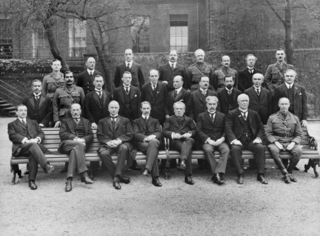
The Imperial War Cabinet (IWC) was the British Empire's wartime coordinating body. It met over three sessions, the first from 20 March to 2 May 1917, the second from 11 June to late July 1918, and the third from 20 or 25 November 1918 to early January 1919. Consisting of representatives from Canada, Australia, India, the Dominion of Newfoundland, New Zealand, South Africa, and the United Kingdom, the Cabinet considered many aspects of waging the First World War. It led to the United Kingdom's Dominions being considered more equal to Great Britain and Ireland. Held concurrently with the cabinet were the Imperial War Conferences of 1917 and 1918.

The Imperial Federation was a series of proposals in the late 19th and early 20th centuries to create a federal union to replace the existing British Empire, presenting it as an alternative to colonial imperialism. No such proposal was ever adopted, but various schemes were popular in Australia, Canada, New Zealand, and other colonial territories. The project was championed by Unionists such as Joseph Chamberlain as an alternative to William Gladstone's proposals for home rule in Ireland.
The state known today as Ireland is the successor state to the Irish Free State, which existed from December 1922 to December 1937. At its foundation, the Irish Free State was, in accordance with its constitution and the terms of the Anglo-Irish Treaty, governed as a constitutional monarchy, in personal union with the monarchy of the United Kingdom and other members of what was then called the British Commonwealth. The monarch as head of state was represented in the Irish Free State by his Governor-General, who performed most of the monarch's duties based on the advice of elected Irish officials.

The territorial evolution of the British Empire is considered to have begun with the foundation of the English colonial empire in the late 16th century. Since then, many territories around the world have been under the control of the United Kingdom or its predecessor states. When the Kingdom of Great Britain was formed in 1707 by the union of the Kingdoms of Scotland and England, the latter country's colonial possessions passed to the new state. Similarly, when Great Britain was united with the Kingdom of Ireland in 1801 to form the United Kingdom, control over its colonial possessions passed to the latter state. Collectively, these territories are referred to as the British Empire. When much of Ireland gained independence in 1922 as the Irish Free State, the other territories of the empire remained under the control of the United Kingdom.

The Lahore Resolution, also called Pakistan Resolution, was written and prepared by Muhammad Zafarullah Khan and was presented by A. K. Fazlul Huq, the Prime Minister of Bengal, was a formal political statement adopted by the All-India Muslim League on the occasion of its three-day general session in Lahore on 22–24 March 1940. The resolution called for independent states as seen by the statement:
That geographically contiguous units are demarcated regions which should be constituted, with such territorial readjustments as may be necessary that the areas in which the Muslims are numerically in a majority as in the North Western and Eastern Zones of (British) India should be grouped to constitute ‘independent states’ in which the constituent units should be autonomous and sovereign.

The Statute of Westminster Adoption Act 1942 is an act of the Australian Parliament that formally adopted sections 2–6 of the Statute of Westminster 1931, an Act of the Parliament of the United Kingdom enabling the total legislative independence of the various self-governing Dominions of the British Empire. With its enactment, Westminster relinquished nearly all of its authority to legislate for the Dominions, effectively making them de jure sovereign nations.
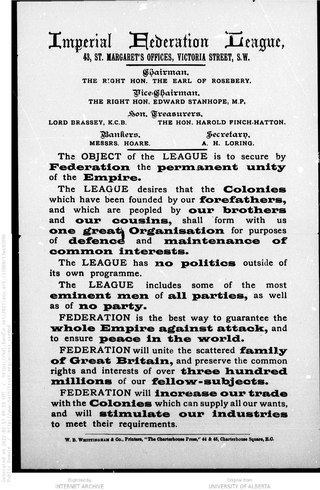
The Imperial Federation League was a 19th-century organisation which aimed to promote the reorganisation of the British Empire into an Imperial Federation, similarly to the way the majority of British North America confederated into the Dominion of Canada in the mid-19th century. The League promoted the closer union of the British Empire and advocated the establishment of "representative government" for the UK, Canada and the self-governing colonies of 'Australasia' and Cape Colony within a single state.
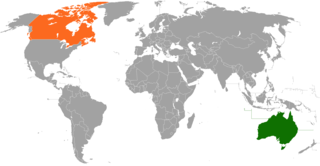
Australia and Canada have a longstanding relationship fostered by both countries' shared history and culture as well as the links between residents of the countries. The two countries are former British Dominions and have a common head of state in King Charles III. Both countries are members of the Asia-Pacific Economic Cooperation, Cairns Group, Commonwealth of Nations, Five Eyes, OECD and the United Nations.
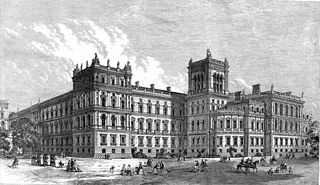
The Colonial Office was a government department of the Kingdom of Great Britain and later of the United Kingdom, first created in 1768 from the Southern Department to deal with colonial affairs in North America, until merged into the new Home Office in 1782. In 1801, colonial affairs were transferred to the War Office in the lead up to the Napoleonic Wars, which became the War and Colonial Office to oversee and protect the colonies of the British Empire. The Colonial Office was re-created as a separate department 1854, under the colonial secretary. It was finally merged into the Commonwealth Office in 1966.
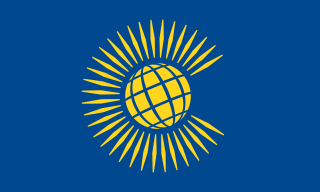
The Commonwealth of Nations, often simply referred to as the Commonwealth, is an international association of 56 member states, the vast majority of which are former territories of the British Empire from which it developed. The chief institutions of the organisation are the Commonwealth Secretariat, which focuses on intergovernmental aspects, and the Commonwealth Foundation, which focuses on non-governmental relations among member states. Numerous organisations are associated with and operate within the Commonwealth.

The 1923 Imperial Conference met in London in the autumn of 1923, the first attended by the new Irish Free State. While named the Imperial Economic Conference, the principal activity concerned the rights of the Dominions in regards to determining their own foreign policy.
A dominion was any of several largely self-governing countries of the British Empire. Progressing from colonies, their degrees of colonial self-governance increased unevenly over the late 19th century through the 1930s, and some vestiges of empire lasted in some areas into the late 20th century. With the evolution of the British Empire into the Commonwealth of Nations, the dominions became independent states, either as commonwealth republics or commonwealth realms.
Commonwealth free trade is the process or proposal of removing barriers of trade between member states of the Commonwealth of Nations. The preferential trade regime within the British Empire continued in some form amongst Commonwealth nations under the Imperial Preference system, until that system was dismantled after World War II due to changes in geopolitics and the pattern of global trade, and the United Kingdom's entry into the European Economic Community. The idea of promoting renewed inter-Commonwealth trade emerged in the late 20th century as a response to the evolution of the global economy. At one extreme, proposals have been raised for the creation of a multilateral free trade area comprising all member states of the Commonwealth of Nations.

Section 3 of the Constitution Act, 1867 is a provision of the Constitution of Canada relating to the union of the original three provinces into Canada. Under the authority of this section, Queen Victoria issued the Proclamation of the Constitution Act, 1867, which brought the Act into force on July 1, 1867, creating Canada.
















